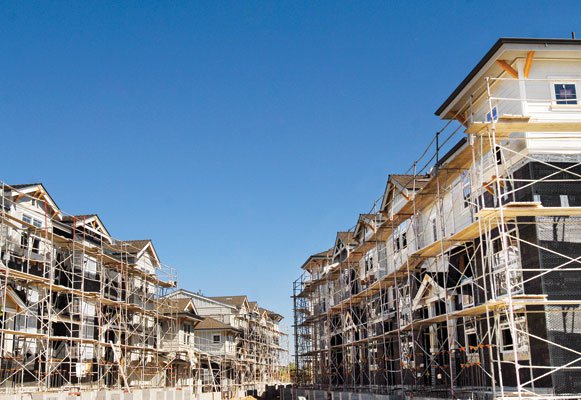After Gov. Gavin Newsom rolled out a deficit-bridging budget plan in January, advocates pushing for more affordable housing and shelters hoped he might reconsider his intent to make deep cuts—or scrounge up some more money.
On May 10, Newsom released a revised proposal showing that he had indeed had a change of heart—though perhaps not exactly the one that advocates were hoping for.
On the one hand, the governor asked the Legislature to restore half a billion in funding to the state’s Low Income Housing Tax Credit program, a signature funding source for affordable housing developers. But on the other, he proposed yet more cuts to an array of state initiatives for low-income renters, first-time homeowners and unhoused residents.
The reinstatement of the tax credits for affordable housing are the “positive news” in a budget that, overall, is “pretty dire” when it comes to housing and homelessness, said Sharon Rapport, director of California state policy for The Corporation for Supportive Housing.
With tax collections coming in weaker than expected, the gap between projected state spending and revenue yawned another $7 billion wider since January, when the projected deficit was still $38 billion. The administration said it was able to cut that shortfall by more than 40% with a series of early cuts, delays and financial rejiggers. But that still leaves a $27.6 billion budget problem that Newsom and Legislature will need to resolve by June 15.
Newsom’s solution, in part: Wipe out the $75 million remaining in the state’s Multifamily Housing Program, California’s workhorse affordable housing funder. That on top of a proposed $250 million cut from January.
He also now wants to drain all remaining funding for a half-billion dollar program to keep existing affordable housing affordable, cut $152 million from a state program for first-time homebuyers and trim $260 million from the Homeless Housing, Assistance and Prevention program. That’s the state’s main source of general homeless funding, and it had dodged cuts in January.
Newsom’s proposed cuts to the Multifamily Housing Program and the grant funding for local homelessness policy are especially dispiriting because those programs focus on helping the lowest income Californians, said Nevada Merriman, vice president of policy at MidPen Housing, a nonprofit affordable housing developer.
“These are the funding sources that the most vulnerable Californians rely upon,” she said.
Newsom proposed fresh cuts on homelessness
On May 10, the governor framed spending less to solve homelessness as a deliberate policy choice meant to exact better results.
“I know that may not sit well with some,” he said, “but we’re struggling with seeing the performance I want to see on the streets.”
For the past few years, Newsom has been sending a message that he expects better results from cities and counties. In 2022, he briefly withheld their funding because, he said, their plans to reduce homelessness weren’t aggressive enough.
And after a scathing audit last month found the state isn’t adequately tracking its spending on or the outcomes of its homelessness programs, lawmakers and advocates have called for more transparency and accountability.
So Newsom now wants to cut $260 million in bonuses that were supposed to be paid out to cities and counties this year and next year. To qualify, recipients had to have two plans approved by the state: one to reduce their homeless populations, and another to plan enough housing for their residents.
His revised budget also lacks any additional money for the state’s main pot of homelessness funding.
For the past three years in a row, Newsom has poured $1 billion into the Homeless Housing, Assistance and Prevention program. Those working in and studying homelessness services worry that without that funding, providers will struggle to continue paying for programs that help people living on the street. Mayors from the state’s 13 largest cities went to Sacramento last month to urge Newsom and the Legislature to provide a permanent, ongoing source of funding for homelessness.
“There’s some shelters that will close as a result of no additional funding in this year’s budget,” Rapport said.
Newsom also wants to cut $132.5 million in this coming fiscal year and $207.5 million the following year from the Behavioral Health Bridge Housing Program—housing for homeless people who have serious mental illness and/or substance use disorder. The program, which began in 2022, was supposed to be a main source of housing for people receiving mandated mental health treatment through Newsom’s new CARE Court.
Newsom acknowledged that “these are tough days,” as he laid out his proposed cuts.
Housing cuts change picture for bond measures
The affordable housing cuts put additional pressure on an ongoing campaign to put a multibillion dollar bond on the November ballot. Last year, Oakland Democratic Assemblymember Buffy Wicks proposed the state borrow $10 billion to replenish its soon-to-be depleted pools of affordable housing funding. If the Legislature goes along with Newsom’s plan, those programs will run dry even sooner.
But Wicks’ bond is competing for space on the November ballot with other borrowing plans to shore up spending on school building upkeep and climate and flood protection.
Separately, regional planners for the nine counties of the San Francisco Bay Area are promoting their own affordable housing bond that could top out at $20 billion—which would be the largest affordable housing bond at any level of government in state history.
Supporters say last week’s cuts also make that campaign all the more urgent.
Last month, the housing nonprofit Enterprise Community Partners estimated that 46,605 affordable homes across California are ready to be built but remain on hold for lack of public funding.
Newsom’s proposed budget “really puts into focus how important the November ballot will be, given California’s volatile budget,” said Merriman.
At his budget presentation on May 10, Newsom was asked if he was receptive to any of the proposed statewide bonds. He didn’t answer the question.
“We’re maintaining a posture of engagement,” he said. “We’ll make a determination.”
Copyright © 2024 Bay City News, Inc. This story was originally published by CalMatters.










